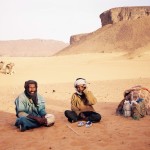Why Mauritania?
Once we started talking about a trip in the Sahara desert, we had to think about where to go.
Fingers on a map
To begin with, this involved little more than looking at maps of North Africa, finding areas that looked interesting and tracing possible journeys with our fingers.
The Michelin 953 (now known as the 741) was great for this and had enough detail to show some of the routes we might follow as well as the larger towns and oases. Certainly enough detail to fuel several excited discussions.
First idea: Egypt to Chad via the Tibesti mountains…
Bill had an early idea for a crossing from Egypt to Chad, touching the corner of Libya and passing through the Tibesti mountains. This was chosen largely because Chad seemed like an unusual country to visit, coupled with the isolation of the Tibesti and all the mountains we could climb there.
…dismissed as too dangerous
The idea was quickly dismissed once we started informed research with the excellent Sahara Overland by Chris Scott. It turned out that there were bandits in Chad as well as landmines. Out of the question. Sudan was also off limits due to civil war.
Sahara Overland
The book was a vast source of information and essential reading for anyone looking to cross the Sahara*. Although it was more oriented towards crossings with vehicles, it was central to our early planning in choosing which parts of the Sahara we could visit. The safest countries in the Sahara were Morocco and Tunisia.** We weren’t keen on these countries as they were both only on the fringe of the desert and frequented by tourists.
Second idea: west to east crossing…
The next safest options were Mauritania, Mali and Niger. This lent itself to a west to east crossing, encountering increasing danger with each new country. We could even wait out the hot summer with a job in Timbuktu if needed.
For a few months this option was “the plan” that was talked about at length between ourselves and to anyone in the college bar who would listen, although to this day I’m not sure if any of us were serious about it.
…but not enough time
Eventually, looking at everyone’s time and budget constraints, we realised that we would have to do a much shorter trip.
Mauritania: sandy desert and camel trading
In contrast to the rocky plateaux that characterise much of the Sahara, Mauritania contained large areas of sandy desert. We thought that would make it more interesting and more scenic.
It also had an economy that was still in part driven by camel trade, which should mean finding camels for our trip would be straightforward.
Finally, Mauritania was said to offer the safest and easiest introduction to Saharan travel. So we decided to start the trip in Mauritania and head east, estimating (with the aid of a discarded plywood map we found in Jordan) we had enough time to reach Timbuktu in Mali.
This route was fine tuned in the final months preceding our departure, as we learned more about Mauritania and Mali, but remained close to our eventual path through the desert.
*The original book is now out of print but Chris Scott has written a new introduction to camel trekking in the Sahara.
**Note: This was at the time we were planning the trip and is likely to be very different today.
Where to go next:


